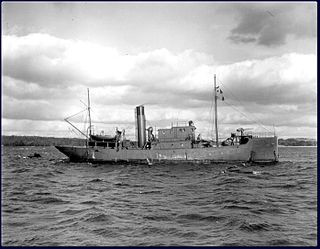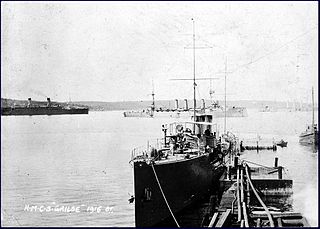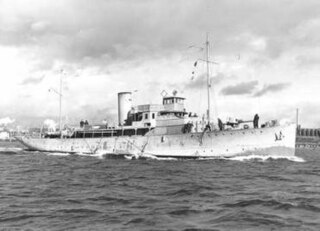Service history
Avalon was constructed by Pusey & Jones of Wilmington, Delaware on order by Ogden L. Mills, the Secretary of the United States Treasury with the yard number 1047. The yacht was launched on 15 October 1928. The vessel was completed in 1931. [lower-alpha 1] In 1939, the vessel was for sale by a Mr. Smith of the Greyhound Bus Company and was laid up at Gulfport, Mississippi.
To augment the local sea defences of East Coast ports during the Battle of the Atlantic, the Royal Canadian Navy (RCN) sought large, steel-hulled yachts to requisition. However, a significant lack of capable vessels were owned by Canadians. Canada turned to its southern neighbour for suitable ships, finding several that met the navy's requirements. However, US neutrality laws prevented their sale to belligerents in the war. In order to circumvent these laws, the RCN requisitioned the yachts of prominent Canadian yachtsmen and then sent them to the US to purchase the yachts that had been identified by the navy without the US government knowing they were working for the navy. The money to acquire the vessels was provided by the Canadian government through bank loans.
The yacht Avalon was among those identified by the RCN as suitable for their needs. Frederick H. M. Jones, a member of the Nova Scotia militia and general manager of the Eastern Trust Company was sent to acquire the vessel. After being purchased by Jones, it took a month for Avalon to travel from Gulfport to Shelburne, Nova Scotia via Miami, Florida and the US East Coast. At Shelburne a Canadian crew took over and made the passage to Halifax, Nova Scotia.
The yacht left Halifax on 23 June 1940 and sailed to Pictou, Nova Scotia where the vessel underwent conversion to an armed yacht. Conversion to an armed yacht involved removing most of the luxurious finery and installing naval hardware.Vison was the last of the Canadian armed yachts to commission in World War II, entering service on 5 October 1940 at Pictou. [lower-alpha 2]
Vison was assigned to Gaspé Force to take part in the Battle of the St. Lawrence after commissioning but in November returned to Halifax for the winter freeze up of the St. Lawrence River and the Gulf of St. Lawrence. In December the yacht was ordered south to Trinidad and Bermuda for the winter months and returned to Halifax on 13 May 1941. With the reopening of the St. Lawrence River, Vison was once again assigned to Gaspé Force in July and remained with the unit until December. That winter, Vison sailed to Trinidad again for the winter months via Halifax.
Upon Vison's return to Canada in April 1942, the yacht was assigned to the Halifax Local Defence Force and then Sydney Force, operating out of Sydney, Nova Scotia in July. On 11 October 1942, Vison was the sole escort of the Corner Brook-Sydney convoy BS-31 comprising two cargo ships. At 1347 GMT, the German submarine U-106 attacked the convoy, firing two torpedoes at SS Waterton, a 2,140 GRT British-flagged vessel. Both torpedoes struck and Waterton began to settle. Vison along with a Consolidated Canso R of 117 Squadron attacked the submarine, with Vison dropping one depth charge initially, followed by a further dozen. Contact was lost and U-106 slipped away. Vison recovered the entire crew of Waterton and continued the escort of the remaining ship. The vessel remained with the force until February 1943, when Vison was reassigned to the training establishment HMCS Cornwallis at Digby, Nova Scotia as a seaman's training ship. Vison was used to train ratings in concert with Royal Navy submarines in the Bay of Fundy until the end of the war. Additionally, the armed yachts stationed at Cornwallis would escort the ferry Princess Helen on run between Saint John, New Brunswick and Digby after the sinking of the passenger ferry Caribou.Vison was paid off on 4 August 1945 and put up for sale. For service in the Battle of the St. Lawrence, Vison was awarded the battle honour "Gulf of St. Lawrence, 1942." [11]
The armed yacht was one of 15 discarded vessels sold to Wentworth MacDonald, an entrepreneur from Sydney, Nova Scotia. Vison was acquired by MacDonald in January 1946. However, there are no records the vessel saw use in the postwar period and McKee believes the vessel may have rotted alongside a pier at Sydney.

HMCS Arleux was one of twelve Battle-class naval trawlers used by the Royal Canadian Navy (RCN). Entering service in 1918 near the end of the First World War, the vessel had a short career with the RCN, being transferred to the Department of Marine and Fisheries in 1922. Arleux was used for fisheries patrol off the east coast of Canada until 1939, when the ship was reacquired by the RCN at the onset of the Second World War. Used as a gate vessel during the war and designated Gate Vessel 16, the ship was sold for mercantile purposes following the war. The ship foundered in 1948 off the coast of Nova Scotia.

HMCS Grilse was a commissioned patrol boat of the Royal Canadian Navy during the First World War. Launched in 1912 as the private yacht Winchester of the American industrialist Peter Rouss, the vessel was constructed along the lines of a contemporary Royal Navy torpedo boat destroyer. After the outbreak of war, vessels that could be used by belligerents was prohibited by the government of the then-neutral United States. Canadian millionaire J. K. L. Ross purchased Winchester and returned to Canada with the yacht, where he transferred ownership of the vessel to the Royal Canadian Navy. Renamed Grilse, a pseudonym for Atlantic salmon and converted to a patrol boat, the vessel was deployed as part of Canada's east coast patrol combating the German submarine threat. After the war, she was sold back to private interests, re-converted to a yacht and renamed Trillora. Trillora foundered in 1938 at Long Island, New York during a hurricane.

HMCS Hochelaga was a commissioned patrol vessel of the Royal Canadian Navy (RCN) that served in World War I and postwar until 1920. Hochelaga is a historic name associated with Canada, the voyages of Jacques Cartier, and the city of Montreal. Initially constructed as the yacht Waturus in 1900 in Europe, the vessel was sold to an American in 1902. The ship was acquired in 1914 for use as a patrol vessel on the East Coast of Canada. Following World War I, the vessel became a ferry between Prince Edward Island and Nova Scotia. After World War II the ship was renamed HaChayal Ha'Ivri and used for illegal Jewish immigration to Palestine. The vessel was scrapped in 1950.
HMCS Beaver was an armed yacht that served in the Royal Canadian Navy during the Second World War. Originally named Aztec, the yacht was requisitioned for service in the United States Navy during the First World War under the same name. Returned to her owner in 1919, the yacht was laid up in 1931 following her owner's death. The vessel was purchased via a third party for service in the Royal Canadian Navy and after commissioning, Beaver was primarily used as a training ship with limited time as a patrol vessel. Following the war she was sold in 1946 and broken up for scrap in 1956.

HMCS Elk was an armed yacht serving with the Royal Canadian Navy during the Second World War. Prior to Canadian service, the ship was named Arcadia. She was used initially as a patrol vessel, but later saw use as a training and guard ship for submarines on the East Coast of Canada. Following the war, Elk was sold for commercial use and returned to her original name. She was renamed Grand Manan III in 1946 and used as a short-haul passenger ferry before being broken up in 1968.

HMCS Raccoon was an armed yacht that served in the Royal Canadian Navy during World War II. Purchased by the Royal Canadian Navy in 1940, the ship was originally known as the yacht Halonia. Used as a patrol vessel and convoy escort, the ship was sunk by the German submarine U-165 in the St. Lawrence River on 7 September 1942. Raccoon was escorting Convoy QS-33 at the time. The entire ship's crew was lost.
HMCS Clayoquot was a Bangor-class minesweeper that served with the Royal Canadian Navy during the Second World War. She saw action mainly in the Battle of the Atlantic. She was sunk in 1944. The minesweeper was named after Clayoquot Sound on Vancouver Island, British Columbia.
HMCS Reindeer was an armed yacht that served in the Royal Canadian Navy during the Second World War. She served mainly in local waters, escorting convoys until becoming a training ship at Halifax, Nova Scotia at the end of 1942. The ship remained as such until being paid off to reserve in 1945 and was sold. Constructed as Josephine in 1926 in the United States and renamed Mascotte, the yacht was acquired by the Royal Canadian Navy in 1940. Following the war, the vessel was sold.
HMCS Noranda was a Canadian Bangor-class minesweeper built for the Royal Canadian Navy in 1940. She was launched on 13 June 1941 and escorted convoys for the rest of the war. After the war the minesweeper was refitted and was transferred to the Royal Canadian Mounted Police as Irvine. In 1962, the ship was sold and was turned into the yacht Miriana. Renamed Marijana and Viking L&R in 1969, the yacht sank in May 1971 off the coast of Jamaica.
HMCS Transcona was a Bangor-class minesweeper built for the Royal Canadian Navy during the Second World War. She was launched on 26 April 1941. After the war, she was transferred to the Royal Canadian Mounted Police under the name French. The vessel served until 1961 before being sold for scrap and broken up later that year.
HMCS Grandmère was a Bangor-class minesweeper constructed for the Royal Canadian Navy during the Second World War. Entering service in 1941, the minesweeper took part in the Battle of the Atlantic and the Battle of the St. Lawrence before being taken out of service in 1945. The ship was sold for mercantile service following the war, first as the yacht Elda and then the cargo ship Jacks Bay. The ship was sold for scrap in 1968.

HMCS Burlington was a Bangor-class minesweeper constructed for the Royal Canadian Navy during the Second World War. The minesweeper entered service in 1941 and took part in the Battle of the Atlantic and the Battle of the St. Lawrence as a convoy escort. The ship was decommissioned in 1945 and sold in 1946. The vessel was broken up for scrap in 1946.
HMCS Medicine Hat was a Bangor-class minesweeper that served with the Royal Canadian Navy during the Second World War. Entering service in 1941, the minesweeper was primarily used as a convoy escort in the Battle of the Atlantic and the Battle of the St. Lawrence. Following the war the vessel was laid up until reacquired during the Korean War. Never re-entering service with the Royal Canadian Navy, Medicine Hat was sold to the Turkish Navy in 1957. Renamed Biga, the minesweeper was discarded in 1963.
HMCS Swift Current was a Bangor-class minesweeper that served with the Royal Canadian Navy during the Second World War. Entering service in 1941, the warship used as a training ship and convoy escort and took part in the battles of the St. Lawrence and the Atlantic. Following the war the ship was laid up until reacquired during the Korean War. Never re-entering service with Canada, Swift Current was sold to the Turkish Navy in 1958. Renamed Bozcaada, the minesweeper was discarded in 1971.
HMCS Truro was a Bangor-class minesweeper that served with the Royal Canadian Navy during the Second World War. The minesweeper entered service in 1942 and took part in the Battle of the Atlantic and the Battle of the St. Lawrence. Following the war, the vessel was transferred to the Royal Canadian Mounted Police and renamed Herchmer. In 1946, Herchmer was sold for mercantile conversion and reappeared as Gulf Mariner. The ship was abandoned in 1964 on the Fraser River shore after plans for conversion to a suction dredger failed. The abandoned hulk was broken up.
HMCS Sans Peur was an armed yacht that served with the Royal Canadian Navy (RCN) during World War II on both coasts. The vessel was constructed as a yacht in 1933 for Ernest G. Stanley at the John I. Thornycroft & Company yard in Woolston, Southampton, United Kingdom and initially named Trenora. It was sold in the 1930s to George Sutherland-Leveson-Gower, 5th Duke of Sutherland who renamed it Sans Peur. The yacht was taken over by the RCN in 1939 and used for anti-submarine patrols and training duties on the British Columbia Coast. In 1944, Sans Peur was brought east to Nova Scotia as a training ship.
HMCS Lynx was an armed yacht in service with the Royal Canadian Navy (RCN) during World War II. The vessel was built at Newport News Shipbuilding as the yacht Dolphin in 1922. The yacht was sold in 1929, becoming Ramona. In 1940, the RCN acquired the vessel as part of the effort to bolster its patrol forces, armed and renamed the vessel Lynx. However, the vessel suffered a series of mechanical issues and was taken out of service in 1943 and sold for commercial service. Renamed Elena and then Samana Queen the ship was used in the banana boat trade, taking on its final name Rican Star in 1952. The vessel was converted to a fishing trawler in 1959 before sinking on 25 May 1960 off Hummocky Island, Queensland.
HMCS Husky was an armed yacht used for patrol and training purposes during World War II by the Royal Canadian Navy. The ship was constructed as the yacht Wild Duck in 1930 in Bay City, Michigan. Having several owners through the 1930s, the vessel was renamed Xania II. Acquired by the Royal Canadian Navy in 1940 for patrol, escort and training duties in Atlantic Canada, the ship was taken out of service at the end of the war and sold into commercial service. The vessel was purchased by the Port of New Orleans, Louisiana for use as an inspection ship. In 1967 the ship was sold again, renamed Aquarius No. 2 and used as a diving tender based in Honduras. In 1979 the vessel was acquired by American interests who brought the ship back to New Orleans and converted it to a floating restaurant.
HMCS Otter was an armed yacht in service with the Royal Canadian Navy during World War II. Launched in 1921, the vessel was constructed as Nourmahal for Vincent Astor of New York as a pleasure yacht. He sold the vessel in the late 1920s and it was renamed Conseco. The Royal Canadian Navy, finding a lack of suitable vessels in Canadian ownership to be taken into naval service, sent Canadian yacht owners south to the United States to find those vessels. Conseco was acquired and brought north to Halifax, Nova Scotia where the vessel was converted to an armed yacht in 1940. Renamed Otter the ship participated in the Battle of the Atlantic, escorting convoys and patrolling the Canadian coast. On 26 March 1941, Otter suffered a catastrophic fire aboard that sank the armed yacht. Two officers and seventeen ratings died in the incident.
HMCS Moose was an armed yacht of the Royal Canadian Navy during World War II. The vessel, originally the yacht Cleopatra constructed in 1930 in Massachusetts, was acquired for port defence in 1940. Following the war, Moose was sold into private ownership and reconverted to a pleasure yacht. Still in service, the vessel has been named Fraternité, Ottelia, Shogun, Naroma, Eretria, Candida A and as of 2019, Uthingo.





